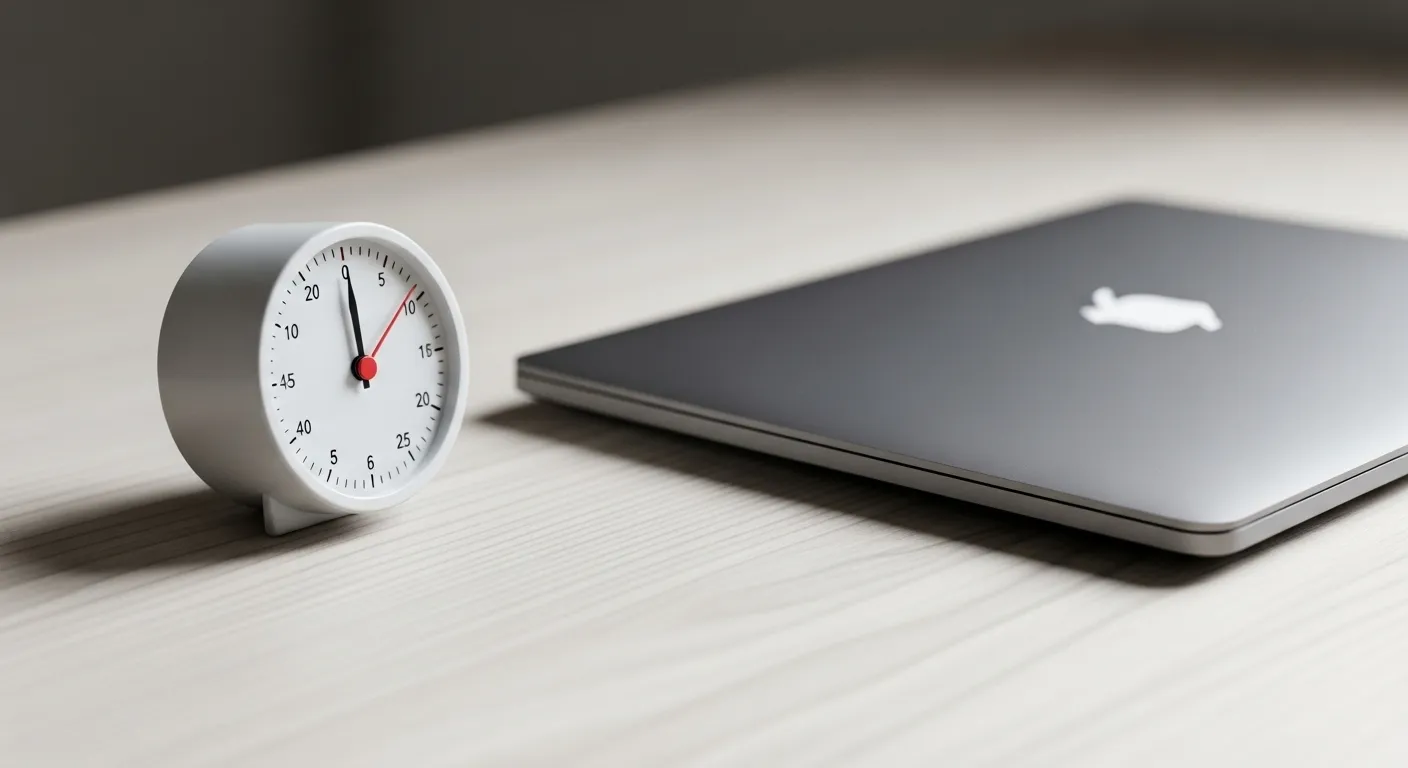
📚 Table of Contents
- The Myth of Motion: Why Your To-Do List Is Full but You Feel Stuck
- Understanding Your Attention: The Engine of Productivity
- Cognitive Load: Your Brain’s Working Memory
- Context Switching: The Hidden Cost of Multitasking
- Flow State: The Peak of Productivity
- How to Be Productive: Four Essential Focus Rituals
- 1. The Startup Ritual: Prime Your Brain for the Day
- 2. The Deep Work Entry Ritual: Master the Art of Monotasking
- 3. Break Hygiene: Recharge Your Attention Battery
- 4. The Shutdown Ritual: End Your Day with Intention
- Your 20-Minute Productivity Starter Pack
- Thought Tools for a Productive Mindset
- 1. Reframe Perfectionism as an Enemy of Progress
- 2. Actively Reduce Friction for Good Habits
- 3. Script Your Reset After Derailment
- Putting It All Together: Two Common Scenarios
- Frequently Asked Questions About Productivity
- 1. Is it okay to listen to music or white noise while I work?
- 2. I feel like I have to multitask. My job demands it. Is it really that bad?
- 3. What should I do on days when I have zero motivation?
- 4. I’m too tired to do anything productive in the evenings. How can I manage my personal life better?
- Your First Step: A Seven-Day Focus Challenge
The Myth of Motion: Why Your To-Do List Is Full but You Feel Stuck
Does this sound familiar? Your calendar is a fortress of overlapping blocks. Your email inbox is a relentless tide. Your to-do list is a sprawling epic, growing longer each day. You are in constant motion, jumping from task to task, answering pings, and putting out fires. You are, without a doubt, busy. But at the end of the day, when you look back, a quiet, nagging feeling surfaces. What did you actually accomplish? Did you move the needle on the projects that truly matter?
This feeling is the friction between being busy and being productive. It’s a modern epidemic of motion without meaning, of effort without impact. Busyness feels like you’re treading water as fast as you can. Productivity feels like a strong, steady swim toward a specific shore. Busyness is measured in hours worked; productivity is measured in outcomes achieved. Busyness is reactive, driven by the demands of others. Productivity is proactive, driven by your own intentions.
Many of us have been taught to equate a full schedule with a successful life. We wear our exhaustion like a badge of honor. But this mindset is a trap. It drains our most valuable resource—our focused attention—and leaves us feeling overwhelmed, scattered, and fundamentally unfulfilled. The constant churn of activity taxes our minds, leading to burnout and diminishing returns.
The good news is that you can escape this cycle. The solution isn’t about working harder or longer hours. It’s not about finding a magical app or a complex new time management system. It’s about understanding the subtle but profound difference between busy and productive work. It’s about learning how to manage your attention, not just your time.
In this guide, we will explore this critical distinction. We will move beyond the surface-level tips and dive into the mechanics of focus. We will give you simple, evidence-aware focus rituals that you can implement immediately to trade the frantic energy of busyness for the calm, centered power of genuine productivity. You can learn how to be productive by working with your brain’s natural rhythms, not against them. Let’s begin the journey from overwhelmed to in control.

Understanding Your Attention: The Engine of Productivity
Before we can build productive habits, we need to understand the raw material we’re working with: our attention. Think of your attention as a finite energy source, like a battery. Every single thing you do during the day, from making a major decision to scrolling through a social media feed, draws power from this battery. The busy vs productive debate hinges entirely on how you choose to spend this precious energy.
A busy person lets their battery be drained by anything and everything that comes their way. A notification, a colleague’s question, a sudden “urgent” email—each one is a small, unplanned withdrawal. By midday, their attention battery is depleted, and they have little energy left for the deep, meaningful work that drives real progress. A productive person, on the other hand, protects their attention. They consciously decide where to invest their energy, allocating it to their most important priorities first.
This isn’t about willpower alone. It’s about understanding a few key concepts about how your mind works.
Cognitive Load: Your Brain’s Working Memory
Imagine your brain has a small workspace, like a mental countertop. This is your working memory. You use it to hold information temporarily while you process it. Cognitive load is the total amount of mental effort being used in this workspace at any given moment. When you try to juggle too many tasks, ideas, or streams of information at once, you overload this countertop. Things get dropped. Information gets muddled. This is why trying to write an important report while monitoring email and listening to a podcast is so ineffective. Your brain simply doesn’t have the capacity to handle all of that high-quality information simultaneously. A key part of productivity is intentionally managing and reducing your cognitive load so you can focus all your mental resources on the single, important task at hand.
Context Switching: The Hidden Cost of Multitasking
For decades, we were told that multitasking was a valuable skill. We now know it’s largely a myth. Our brains aren’t built for parallel processing complex tasks. What we are actually doing is something called context switching. This is the act of rapidly toggling your attention between different, unrelated tasks. Each time you switch—from your report to your inbox and back again—your brain has to disengage from the first context, load up the second one, and then do it all over again when you switch back. This process isn’t free. It costs time and mental energy, a kind of cognitive tax. Research from organizations like the American Psychological Association (https://www.apa.org) suggests that even brief mental blocks created by shifting between tasks can cost as much as 40 percent of someone’s productive time. Busyness is a state of constant, exhausting context switching. True productivity minimizes it.
Flow State: The Peak of Productivity
Have you ever been so absorbed in an activity that time seems to melt away? You’re fully immersed, energized, and performing at your best. This is the flow state, a concept popularized by psychologist Mihaly Csikszentmihalyi. It’s the pinnacle of productive experience, where your skills are perfectly matched to the challenge at hand. You can’t force a flow state, but you can create the conditions for it to emerge. This means eliminating distractions, clarifying your objective, and dedicating a sustained block of time to a single task. A busy day, filled with interruptions and context switching, is the natural enemy of flow. A productive day creates space for it to happen.
Understanding these concepts is the first step. You see that productivity isn’t about hustling harder; it’s about working smarter by respecting your brain’s limitations and leveraging its strengths. The goal is to move from a state of high cognitive load and constant context switching to one of focused attention where flow is possible.

How to Be Productive: Four Essential Focus Rituals
Knowing the theory is one thing. Putting it into practice is another. The bridge between understanding productivity and being productive is built with rituals. Rituals are simply intentional, repeatable sequences of actions that signal to your brain what it should be doing next. They reduce friction, automate decision-making, and conserve your precious mental energy for the task itself. Here are four simple yet powerful rituals you can adopt to shift from busy to productive.
1. The Startup Ritual: Prime Your Brain for the Day
How you start your day often determines how the rest of it will unfold. A reactive start—grabbing your phone and immediately diving into emails and notifications—puts you in a defensive crouch. You’re reacting to everyone else’s agenda. A Startup Ritual allows you to set your own agenda first.
It doesn’t need to be long or complicated. The goal is to create a clear, calm transition into your workday. It involves two simple steps: a brain dump and prioritization. First, get every single task, worry, and idea out of your head and onto a piece of paper or a digital document. This clears your cognitive load. You’re not trying to hold it all in your mind anymore. Second, look at that list and ask yourself: “If I could only accomplish one to three things today to feel successful, what would they be?” Identify your Most Important Tasks (MITs). These are your priorities. Your mission for the day is now to protect the time and energy needed to complete these MITs. Everything else is secondary.
2. The Deep Work Entry Ritual: Master the Art of Monotasking
Deep work is where real progress happens. It’s the work that requires your full, uninterrupted concentration. But transitioning into that state can be hard. An Entry Ritual is a 2-3 minute sequence that acts as a runway into deep focus.
It starts with defining a clear objective for the session. What does “done” look like for this work block? Write it down. Next, eliminate distractions. Close all irrelevant tabs and applications. Put your phone in another room or turn it on Do Not Disturb. Finally, take three slow, deep breaths. This simple act calms your nervous system and signals a shift in mental state. You are now ready to engage in monotasking, the practice of dedicating your focus to a single task at a time. It is the direct antidote to the productivity-killing habit of context switching.
3. Break Hygiene: Recharge Your Attention Battery
Your brain is like a muscle; it needs rest to recover and perform at its best. Non-stop work doesn’t lead to better output; it leads to burnout. The difference between busy and productive people is often found in how they take breaks. A busy person might “rest” by scrolling through social media or checking news headlines. While this feels like a break, it’s actually just another form of cheap stimulation that continues to drain your attention battery.
Productive breaks involve genuine rest. This means stepping away from screens. Stand up, stretch, walk around, look out a window, or grab a glass of water. According to research bodies like the National Institutes of Health (https://www.nih.gov), even short breaks involving physical movement can improve cognitive function. Try the Pomodoro Technique: 25 minutes of focused work followed by a 5-minute screen-free break. This rhythm of intense focus followed by deliberate rest is a cornerstone of sustainable time management and productivity.
4. The Shutdown Ritual: End Your Day with Intention
The “always-on” culture makes it difficult to truly disconnect from work. A Shutdown Ritual creates a firm boundary between your workday and your personal life, allowing your brain to fully rest and recharge for the next day. It prevents work from bleeding into your evening and night, which is crucial for long-term well-being.
Your shutdown should take about 5-10 minutes. First, review your day. Acknowledge what you accomplished, especially your MITs. Second, look at your to-do list and quickly plan your priorities for tomorrow. This transfers your plans from your brain to an external system, preventing you from ruminating on work tasks overnight. Finally, do a physical action that signifies the end of the day. It could be closing your laptop, tidying your desk, or saying a specific phrase like “work is done.” This tells your brain it’s officially time to switch off.
Your 20-Minute Productivity Starter Pack
Feeling overwhelmed by all this? Don’t be. Here’s a simple way to start:
Morning (5 minutes): Don’t check your phone. Instead, take one piece of paper. Write down the 1-2 most important things you need to do today.
Before Your First Big Task (2 minutes): Close everything else on your computer. Set a timer for 25 minutes. Take one deep breath. Start.
After 25 Minutes (3 minutes): Stand up. Walk to the kitchen and get a glass of water. Do not look at your phone.
End of Day (10 minutes): Review your list. Did you do the important things? Great. Write down the top priority for tomorrow. Close your computer. Day complete.
That’s it. Just 20 minutes of intentional action can completely reshape the busy vs productive dynamic of your day.

Thought Tools for a Productive Mindset
The best rituals and time management techniques in the world will fail if your underlying mindset works against you. The battle between busy and productive is fought not just on your calendar, but in your mind. Cultivating a productive mindset involves challenging unhelpful beliefs and building mental models that support focus and well-being. Here are three powerful thought tools to add to your arsenal.
1. Reframe Perfectionism as an Enemy of Progress
Perfectionism often masquerades as a commitment to high standards. In reality, it is a major barrier to productivity. It causes us to procrastinate on starting important tasks because we fear the outcome won’t be flawless. It makes us spend hours on trivial details that have little impact on the final result. It drains our energy with anxiety and self-criticism.
The antidote is to adopt a “good enough” mindset for most tasks. This doesn’t mean producing sloppy work. It means recognizing the point of diminishing returns. Ask yourself: “What is the core purpose of this task?” and “What level of quality is truly required to achieve that purpose?” Focus on completing a solid first version, knowing you can always iterate and improve it later if necessary. Remember the phrase: “Done is better than perfect.” Shipping a good project is infinitely more productive than endlessly polishing a perfect one that never sees the light of day.
2. Actively Reduce Friction for Good Habits
Every action you take has a certain amount of “friction” associated with it—the effort required to start. Unproductive habits, like checking your phone, have almost zero friction. It’s right there, easy to grab. Productive habits, like deep work, often have more friction. You have to open the right software, find the right file, and resist the urge to do something easier.
You can dramatically improve your productivity by deliberately manipulating friction. Increase the friction for your distractions. Log out of social media accounts at the start of your workday. Move distracting apps to a folder on the last page of your phone’s home screen. Put your phone in a drawer in another room. Conversely, decrease the friction for your good habits. If you want to work on a report first thing, leave that file open on your computer when you shut down the night before. If you want to exercise in the morning, lay out your workout clothes before you go to bed. By making it easier to do the right thing and harder to do the wrong thing, you guide yourself toward productivity without relying solely on willpower.
3. Script Your Reset After Derailment
No one has a perfectly productive day, every day. You will get distracted. You will have a day where you feel unmotivated. You will get pulled into a series of unexpected meetings. This is not a failure; it is a reality of life. The difference between a busy person and a productive person is how they respond to this derailment.
A busy mindset sees a derailed morning as a reason to write off the entire day. “Well, my plan is ruined, so I might as well just answer emails and wait for tomorrow.” A productive mindset knows how to reset. You need a simple, pre-planned script for when things go wrong. It might sound like this: “Okay, that was not the plan. I feel frustrated. I will now take three deep breaths. I will look at my list of priorities. What is the one next thing I can do in the next 15 minutes to get back on track?” This script acknowledges the emotion without judgment and provides a clear, small, actionable next step. It’s a moment of self-compassion and gentle redirection that can salvage a day that feels lost.
These thought tools are practices, not one-time fixes. By consciously working to reframe perfectionism, manage friction, and develop a reset script, you build the mental resilience and flexibility that are the true foundations of sustainable productivity.

Putting It All Together: Two Common Scenarios
Theory is helpful, but seeing these principles in action is what makes them stick. Let’s walk through two common, challenging scenarios to see how someone might apply these focus rituals and thought tools to shift from a busy, reactive state to a productive, proactive one.
Scenario 1: The Tight Deadline Project
The Busy Approach: Sarah has a major report due in two days. She feels immense pressure. She sits down at her desk, opens her email, and immediately gets sidetracked by a dozen “urgent” but unimportant requests. She keeps the report file open but also has 20 other tabs running. She works frantically for an hour, typing a sentence here, answering an email there, and checking a notification on her phone. She feels exhausted and stressed, and the report has barely progressed. She tells herself she needs to “just power through” and plans to work late into the night, fueled by caffeine.
The Productive Approach: Mark also has a major report due in two days. He recognizes the pressure but knows frantic energy won’t help. He starts his day with his Startup Ritual. He ignores his inbox and identifies writing the first draft of the report as his single Most Important Task. He then begins his Deep Work Entry Ritual. He closes all other applications, puts his phone in another room, and clearly defines his goal for the next 90 minutes: “Complete the introduction and Section 1.” He works with intense, unbroken focus (monotasking). After 90 minutes, he takes a 15-minute screen-free break to walk around and clear his head. He repeats this cycle. When an anxious thought about perfectionism arises, he uses a thought tool, telling himself, “The goal is a solid first draft, not a perfect final version.” By the end of the day, he has a complete, high-quality draft and can shut down at a reasonable hour, feeling accomplished, not just exhausted.
Scenario 2: The Noisy Home Environment
The Busy Approach: David works from home with family members who are often loud. He tries to work on a complex analysis but is constantly interrupted by conversations in the next room, a dog barking, and the sound of the TV. He gets frustrated, putting on headphones and blasting loud music, which only adds to his cognitive load. He finds himself re-reading the same paragraph over and over. He gets angry and complains about the noise, draining his emotional energy. His “work” day becomes a piecemeal effort of five minutes of focus here, ten minutes there, punctuated by frustration and distraction.
The Productive Approach: Maria also works in a noisy home. She knows she can’t control the environment completely, so she focuses on what she can control. She uses her Startup Ritual to identify the one task that requires the most focus. She communicates with her family: “I need to concentrate for the next 60 minutes. I’m going to close the door and put on my headphones. Please only interrupt me for a true emergency.” This sets a clear boundary. She reduces friction by having her noise-canceling headphones and a pre-selected focus playlist (instrumental music or white noise) ready to go. When an unavoidable interruption happens, she doesn’t let it derail her. She uses her Reset Script: “Okay, that was a distraction. I will take a deep breath and re-read the last sentence I wrote to get back into it.” She works in focused bursts, aligning them with quieter moments in the household, and uses her breaks to engage with her family, rather than fighting the environment all day. She makes tangible progress despite the imperfect conditions.

Frequently Asked Questions About Productivity
As you begin this journey, questions will naturally arise. It’s part of the process of tailoring these ideas to your unique life and work style. Here are answers to some of the most common questions we hear from people trying to understand the difference between busy and productive work.
1. Is it okay to listen to music or white noise while I work?
This is a great question, and the answer is: it depends. For some people, especially in a noisy environment, music or white noise can be a powerful tool to mask distracting sounds and signal to the brain that it’s time to focus. The key is the type of audio. Music with lyrics can be very distracting because it engages the language centers of your brain, increasing your cognitive load. For deep focus tasks like writing or analysis, instrumental music, classical music, ambient sounds, or white/brown noise are generally better choices. The goal is to create a consistent, predictable soundscape that your brain can tune out, not a stimulating one that it wants to pay attention to. Experiment and see what works for you.
2. I feel like I have to multitask. My job demands it. Is it really that bad?
This is a common belief in many modern workplaces. It’s important to distinguish between true multitasking (which is impossible for complex tasks) and rapid task switching. While some jobs require you to be responsive, the myth is that you can do it all at once without a cost. The cost is context switching. You pay a mental tax every time you shift your attention. The solution is not to ignore everything, but to batch your tasks. Instead of checking email every three minutes, create a ritual to check and process it three times a day. Instead of responding to every instant message immediately, dedicate specific “office hours” blocks for communication. You can be highly responsive without living in a state of constant interruption. This approach allows you to create the space for the deep work that truly drives your success.
3. What should I do on days when I have zero motivation?
Motivation is a feeling, and feelings are unreliable. Productive people don’t wait for motivation to strike; they rely on their rituals and systems. On a low-motivation day, your how to be productive strategy should be to lower the bar. Don’t aim for a perfect, three-hour deep work session. Use the “reduce friction” thought tool. Commit to just five minutes. Tell yourself, “I’m just going to open the document and write one sentence.” Or, “I’ll work on this for just 15 minutes.” More often than not, taking that first small, easy step is enough to get the flywheel turning. Action often precedes motivation, not the other way around. Be compassionate with yourself, but don’t let the feeling of “no motivation” be a reason to do nothing.
4. I’m too tired to do anything productive in the evenings. How can I manage my personal life better?
This is a crucial point. The goal of productivity is not to optimize every second of your life for output. It’s to create more space and energy for the things that matter, including rest, hobbies, and relationships. If you’re exhausted by the end of the workday, that’s a signal. Your Shutdown Ritual is your most important tool here. By creating a clear end to your workday and planning the next day, you give your brain permission to stop thinking about work. This allows for true recovery. Use the energy you have in the evenings for restorative activities, not more “productive” tasks. Read a book, talk with a loved one, go for a walk. This is not laziness; it’s a vital part of the productivity cycle. A well-rested brain is a focused and creative brain.

Your First Step: A Seven-Day Focus Challenge
Understanding the busy vs productive mindset is the first step. Now, it’s time for a small, simple action. Knowledge is only potential; action is power. The best way to make these ideas stick is to try them out in the real world. We invite you to take a simple, seven-day focus challenge.
Don’t try to implement everything at once. That’s a recipe for overwhelm, which is exactly what we’re trying to escape. Instead, for the next seven days, commit to practicing just three small things. These actions are designed to give you the highest return on your investment of attention.
Action 1: Define Your “One Thing” Each Morning. Before you check your email or phone, take two minutes. Ask yourself: “If I only get one thing done today, what will make the biggest impact?” Write it down on a sticky note and place it on your monitor. This is your guiding star for the day.
Action 2: Schedule One 30-Minute “Monotask” Session. Look at your calendar and block out just 30 minutes for uninterrupted, single-task focus on your “one thing.” During this block, close all other tabs. Put your phone on silent and out of sight. Set a timer. When the timer goes off, you’re done. Celebrate that you protected your focus.
Action 3: End Your Day with a 5-Minute Shutdown. Before you walk away from your workspace, take five minutes. Look at what you did. Acknowledge your effort. Then, decide on your “one thing” for tomorrow. Close your computer with the intention of being fully done with work for the day.
That’s it. Three small shifts. This isn’t about radically overhauling your entire life overnight. It’s about taking small, deliberate steps away from the chaos of busyness and toward the calm clarity of productivity. Pay attention to how you feel at the end of each day. You might just notice a little less overwhelm, a bit more accomplishment, and a renewed sense of control. This is the path to sustainable, meaningful work.
Disclaimer: The information provided in this article is for informational purposes only and is not intended as a substitute for professional medical or psychological advice, diagnosis, or treatment. Always seek the advice of your physician or other qualified health provider with any questions you may have regarding a medical condition or mental health concern.






